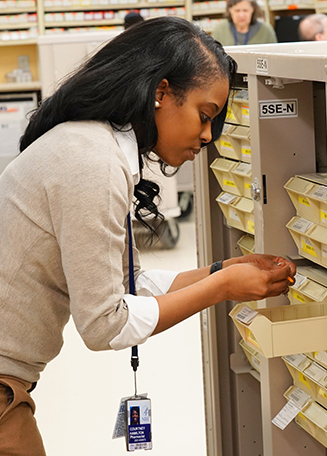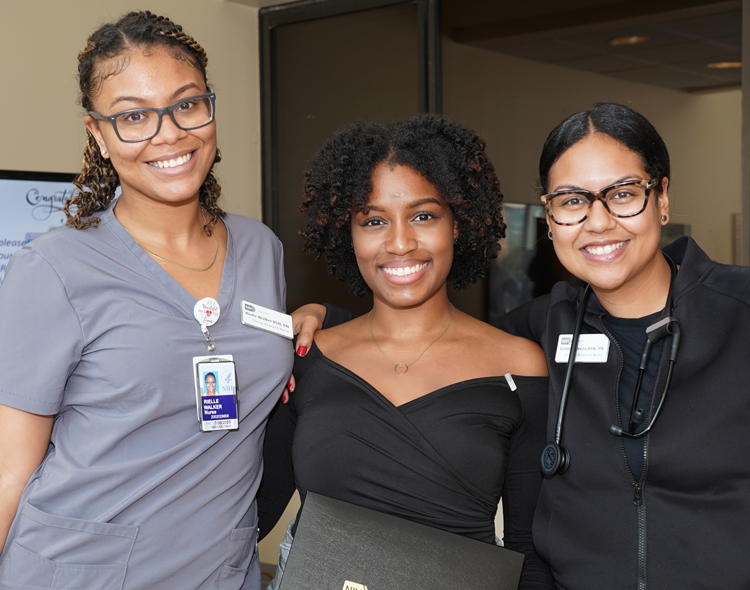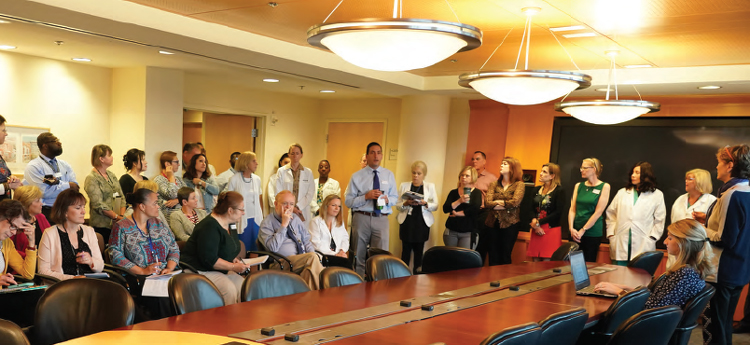
For many years, leadership in the CC rested with senior staff born during or just after World War II. Most came from the generation whose parents lived through the Great Depression. They value structure, stability, and job security and were known for a strong work ethic. Members of generations that came after, uphold these values and have effectively established expectations related to work life balance and career development.
The details of generational differences and the impact those differences have on trans-generational understanding are beyond the scope of this document. It is sufficient to note that within a decade the CC will be led by representatives of new generations facing different challenges from global issues to environmental crises and new socio-cultural priorities. Acceptance of this reality is a necessary starting point if we are to recruit and retain the best and brightest.
Communication
The CC must provide forums that enable trans-generational and interdisciplinary communication. In particular, the voices of new generations must be heard at the most senior levels of the CC. The opportunities must be well-integrated, recurring, and systematic if the CC is to adapt personnel practices and policies that will serve the next generations as well as, or better than, the past and current practices and policies.
New generations are accustomed to a world of instant, wide-ranging, and barrier free communication tools that allow them to quickly and dynamically interact with both friends and complete strangers. The information cycle has no beginning and no end. Our efforts to enhance trans-generational communication must account for the disruptive developments of a revolution in communication.
Similarly, efforts to advance the principles of high reliability in healthcare require increased open-minded approaches based on educational background or training, keeping the patient at the center of everything we do, and recognizing that diversity of opinions provides the greatest opportunity for successful outcome and the best results for the patient.
Culture of Patient Safety, and Regulatory Compliance
Our efforts to improve the patient safety program and move aggressively into the realm of high reliability in healthcare delivery have been transformative over the past three years. Eliminating patient harm in the clinical research environment is a huge undertaking. It requires a critical review of existing systems and processes to identify risk and efficiencies. It requires a focus on staff education and training. Most of all it requires empowerment of frontline staff. We have made great progress in our journey toward high reliability, but we still have much to do. While we address other aspects of CC culture, we will remain relentless in our efforts to protect our patient-partners from preventable harm.
Regulatory requirements governing clinical research are numerous and complex. The CC must provide assistance to investigators who need to meet these requirements without detracting unnecessarily from the scientific efforts. Smaller IC's require more assistance than larger IC's. The Office of Research Support and Compliance (ORSC) was established in 2017 and ensures the quality and integrity of clinical research and product manufacturing/compounding conducted at the NIH. As its name suggests, this office provides regulatory and compliance support and guidance for all NIH researchers in the areas of protocol navigation and coordination, quality assurance auditing and monitoring, support for Food and Drug Administration (FDA) regulated studies and centralized facility oversight. During the period of time covered by this plan, the CC will continue to develop a robust ORSC that will continue to facilitate clinical research efforts while making it easier for investigators to deal with ever increasing regulatory requirements.
A high priority focus on organizational performance metrics by our CC Research Hospital Board (CCRHB) involves standing metrics reports and updates for every quarterly meeting with a focus on metrics for operations, safety performance, infection control, nursing quality, clinical outcomes, quality and regulatory compliance, employee safety, etc. Programmatic improvements are consistently implemented in response to CCRHB members' recommendations. Metrics reported to the CCRHB are also posted regularly on the CC website: https://go.usa.gov/xmesj.
Operational metrics, including patient census trends, protocol activity, and staffing are tracked closely by the executive team and reported to the CC Governing Board. Looking ahead, organizational plans include a strategic review of the CC's current metrics portfolio, addition of medication management metrics, identification of additional outcomes metrics to complement process assessments and the launch of a public display of clinical metrics on patient care units and other public spaces in the CC.
Culture of Mentorship, Diversity and Inclusion

People have very different notions of what mentorship means. However, there may be a more general consensus about the attributes of a mentoring culture. These attributes include an expectation of teamwork, shared accountability for successes and failures, respect for both expertise and experience, and a full understanding that the clinical research mission of the CC transcends generations and disciplines. Thus, each generation of researchers, research support staff, clinicians, administrators, and clinical research nurses learns from the previous generation and passes knowledge and wisdom to the generation that follows. Leaders are crucial to this culture, but peers and staff at all levels are equally as important.
Our guiding principle of diversity and inclusion reflects our commitment to staff, patients, family members, and volunteers alike. Of particular note is the NIH's program to combat all forms of harassment, including gender harassment, throughout the NIH community. Within the overarching NIH program is a CC effort to identify and address harassment or bullying involving patients or their family members. This initiative is in its infancy. However, its success is crucial if we are to establish the culture and environment that attracts the best employees regardless of gender, ethnicity, religion, race, gender identification, or sexual orientation.
Recruiting
Understanding generational differences is crucial to improving our ability to recruit the next generation of "NIH-ers". The National Capital Region and neighboring areas have a wealth of top-shelf schools producing medical scientists, nurses, administrators, and practitioners. The CC Office of Clinical Research Training and Medical Education maintains relationships with many of these institutions. The CC Nursing Department has relationships with programs from across the country, and a number of CC departments have arrangements with local programs training technologists and technicians. Residency programs for new graduates in disciplines like pharmacy and nursing will be important in attracting talented new staff members. Training agreements and residency programs will be supported and, when possible, expanded. This will give the CC a chance to experience more students and trainees early in their careers. The education and training mission complements and completes the patient care and research missions of the CC.
Recruiting of key CC staff cannot be done in a vacuum. Leaders among the CC staff provide service support to other ICs while a number also maintain independent research programs. The ability to balance research and research support is the unique and defining characteristic of CC leaders. It's very important to involve IC staff who are dependent on the CC for common services (such as laboratory testing or imaging) in the search and selection process of CC departmental leaders.
CC department chiefs lead groups of 150 or more staff members. Morale impacts the engagement, satisfaction, and retention of staff clinicians, technologists, technicians, and administrative staff alike. Adding new voices to the recruiting and selection processes will be especially important as the CC continues to recruit and retain a diverse group of staff members and leader.
One key program hosted by the CC that has palpable strategic importance to the NIH is the Medical Research Scholars Program (MRSP). There needs to be adequate resources for the logistical support of this program, assuring that promising students have a positive NIH experience early in their careers. The hope is that it may lead to additional NIH training and scientific experiences later in their careers. Under new leadership, the goal is for the MRSP to expand its footprint within the NIH Intramural Research Program, the internal research program of NIH. The CC will do its part in support of this goal.
Additional key programs are the Presidential Management Fellows and Management Intern programs. CC participation in these programs should be a high priority and more consistent.
Retention

The unique clinical mission of the CC within the NIH family makes it very hard for our centralized human resources office to tailor retention efforts to CC staff. Many CC personnel practices and policies are set by the Office of Personnel Management, the Department of Health and Human Services, and NIH, but there is still a great deal under CC control.
Schedules and work assignments are one such area under CC control. Details of the updated personnel practices and policies will evolve over time. However, one anticipated key attribute will be greater flexibility. When establishing work schedules, we need to make more allowances for individual career goals, aptitudes, potential, stage of career development, and personal and family circumstances that change over time. The opportunity to telework is often cited in employee surveys as an important satisfier, and telework is encouraged within the federal government. Efforts to establish policies that increase teleworking opportunities will be explored (while recognizing that not all work in the CC lends itself to telework, that telework-friendly projects may be time limited, and telework requests should be reviewed based on the needs of the CC as well as the desires of the staff members).
Staff members are often reluctant to forego new work opportunities to continue to do the same job year after year. Opportunities for staff members, especially those just completing their education, to explore varied opportunities within their disciplines rather than being expected or required to stay in the same narrow lane have to be carefully studied. The goal is to retain as many staff members as possible who are capable of doing any number of jobs well.
Financial retention incentives (e.g., loan repayment programs) are available but poorly understood and, all too often, applied in an ad hoc manner. Similarly, education and training opportunities cover a broad spectrum but even these benefits are not always addressed systematically. Without the creation of excessive bureaucracy, the use of retention incentives should be applied in a more systematic and programmatic fashion. Use of these incentives should be more transparent than has past been the case.
A disciplined, systematic retention program starts with a better understanding of the goals, aspirations, and dreams of our staff members. An annual paint-by-numbers review as part of a deadline-driven performance appraisal doesn't cut it. Individual development plans should be the rule and not the exception. Research indicates that Millennials welcome feedback. Regular (e.g. quarterly) meetings for constructive feedback and counseling will allow earlier detection of employee dissatisfaction. Such meetings can also spur consideration of the timely, more effective use of retention incentives.
Awareness
We encounter many regional and national healthcare leaders who are unaware that NIH runs a research hospital, fully accredited by The Joint Commission. Recruiting the best talent and retaining that talent requires that the CC establish a separate identity within the larger NIH brand. Opportunities to market the unique resources and capabilities of the CC must be actively sought and addressed in a strategic fashion – one message with many voices.
Awareness is important to our staff recruiting efforts. The recognition that stems from elevated public awareness contributes to retention as well.
Organization
The unique mission of the CC resulted in the evolution of a unique structure. In the CC, service providers such as the pharmacy, laboratory medicine, radiology, transfusion medicine, perioperative medicine, and rehabilitation medicine are larger than in many comparable facilities in order to support both clinical care and ICs' clinical research. However, clinical departments such as medicine, pediatrics, and surgery are small in comparison to other academic medical centers. As the time commitments to independent scientific efforts have grown, a number of clinical researchers have yielded clinical responsibilities to staff members devoting most of their time to providing patient care.
In commercial healthcare, the spread of the hospitalist movement is indicative of the perceived value of specialization of function, as opposed to training and education. In the CC, Critical Care Medicine Department functions rely on hospital-based intensivists exclusively. The pediatrics inpatient and observation units are rapidly evolving toward that model as well. The medical oncology service uses hospitalists during the busy day shifts Monday through Friday but, at present, reverts to a more traditional model in which IC-based teams provide coverage during weekends and nights.
While there are no current plans to require use of the hospitalist model throughout the CC, the movement in that direction is clear. At the same time that the impact of using the hospital-based physician model on patient safety, patient and family satisfaction, and patient engagements is assessed, the resource requirements of employing this model more generally will be determined as this strategic plan is implemented.
Summary
Even in the electronic age, all measures of healthcare quality – clinical, functional, economic, and patient perceptions – are determined in the human domain. Recruiting, developing, and retaining the right people requires building the right culture and then organizing the staff in ways that simplify the enormous complexities encumbering the clinical research environment.

